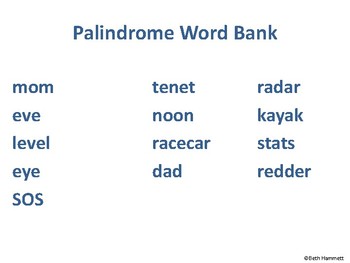
Decoding Palindromes: Examples and Insights into Linguistic Symmetry
Palindromes, words, phrases, or sequences that read the same backward as forward, have captivated language enthusiasts and mathematicians for centuries. They represent a unique form of linguistic symmetry, offering a playful yet profound exploration of language structure. This article delves into the fascinating world of palindromes, providing numerous example of palindrome, exploring their history, and examining their presence in various aspects of culture and science.
What is a Palindrome?
At its core, a palindrome is a sequence that remains unchanged when its elements are reversed. This can apply to single words, phrases, numbers, or even more complex sequences like DNA strands. The key characteristic is the perfect symmetry around a central point, making it readable identically in both directions. The simplest example of palindrome is the word “madam”.
Classic Examples of Palindromes
Let’s explore some well-known example of palindrome across various categories:
Word Palindromes
- Level: A common and straightforward example of palindrome.
- Radar: Another widely recognized example of palindrome often used to illustrate the concept.
- Kayak: A fun and easily relatable example of palindrome.
- Refer: A simple verb showcasing palindromic properties.
- Racecar: A slightly longer and more descriptive example of palindrome.
Phrase Palindromes
Phrase palindromes are more complex, often requiring adjustments to punctuation and spacing to achieve symmetry.
- “A man, a plan, a canal: Panama”: A famous example of palindrome, demonstrating creative sentence construction.
- “Madam, I’m Adam”: A classic introduction, highlighting the symmetrical nature of the names.
- “Never odd or even”: A succinct and memorable example of palindrome.
- “Was it a car or a cat I saw?”: A more complex sentence, illustrating the ingenuity involved in creating phrase palindromes.
Numerical Palindromes
Numbers can also be palindromic. These are numbers that read the same backward as forward.
- 121: A basic numerical example of palindrome.
- 12321: A slightly longer numerical palindrome.
- 11:11: Time as a palindrome.
- 9009: Another numerical example of palindrome.
The History and Cultural Significance of Palindromes
Palindromes have a rich history, dating back to ancient times. The earliest known palindrome was found in Herculaneum, a city buried by the eruption of Mount Vesuvius in 79 AD. The Sator Square, a word square containing the Latin palindrome “Sator Arepo Tenet Opera Rotas,” has been discovered in various locations, suggesting its use as a charm or religious symbol. This historical example of palindrome demonstrates the early fascination with symmetrical language.
Throughout history, palindromes have appeared in literature, poetry, and puzzles. They are often used to showcase linguistic skill and creativity. In some cultures, palindromes are believed to possess magical or mystical properties.
Palindromes in Science and Technology
Interestingly, palindromes aren’t confined to language and mathematics. They also play a significant role in molecular biology, particularly in genetics. DNA sequences can be palindromic, meaning that the sequence of nucleotides reads the same on both strands of the DNA double helix when read in opposite directions. These palindromic sequences are often recognition sites for restriction enzymes, which are crucial tools in genetic engineering. This scientific example of palindrome highlights their functional importance beyond mere linguistic curiosity. Restriction enzymes recognize specific palindromic sequences and cut the DNA at or near these sites.
Creating Your Own Palindromes
Creating palindromes can be a fun and challenging exercise in wordplay. Here are some tips for crafting your own palindromes:
- Start Simple: Begin with short words or phrases and gradually increase the complexity.
- Focus on Symmetry: Pay close attention to the symmetrical arrangement of letters.
- Use a Thesaurus: Explore synonyms and related words to find suitable matches.
- Be Creative: Don’t be afraid to experiment with different word combinations and sentence structures.
- Consider Punctuation and Spacing: Remember that punctuation and spacing often need to be adjusted to create a true phrase palindrome.
Why Palindromes Matter
While seemingly a trivial pursuit, the study of palindromes offers insights into the structure of language and the human fascination with symmetry. They challenge our understanding of word order and demonstrate the creative potential of language. Moreover, their presence in fields like genetics underscores the broader significance of symmetrical patterns in the natural world. Finding an example of palindrome is often a fun exercise that encourages creativity.
Palindromes provide a unique lens through which to view language and the world around us. From simple word palindromes like “rotor” to complex phrase palindromes such as “Doc, note, I dissent. A fast never prevents a fatness. I diet on cod,” they showcase the beauty and ingenuity of linguistic symmetry. Exploring palindromes is not just an exercise in wordplay; it’s an exploration of patterns, structure, and the human capacity for creative expression. The continued fascination with palindromes ensures their enduring presence in language, literature, and beyond. Consider “deified” as another example of palindrome that reflects this reverence.
In conclusion, the example of palindrome are numerous and diverse, spanning across words, phrases, and even numbers. Their presence in various fields, from ancient history to modern genetics, highlights their enduring appeal and significance. Whether you’re a language enthusiast, a puzzle solver, or simply curious about the world around you, exploring the world of palindromes offers a rewarding and intellectually stimulating experience. The next time you encounter a palindrome, take a moment to appreciate the elegant symmetry and the cleverness of its construction.
Understanding the concept using example of palindrome like “civic” or “stats” is crucial for grasping their linguistic significance. The search for new and interesting palindromes continues, fueled by the human desire to find order and symmetry in the world.
The beauty of a palindrome lies in its simplicity and complexity. A simple example of palindrome, such as the word “eye,” demonstrates the basic principle, while more elaborate phrases reveal the artful manipulation of language required to achieve perfect symmetry. This duality is what makes palindromes so captivating and worthy of continued exploration.
[See also: Linguistic Curiosities and Wordplay]
[See also: The Mathematics of Symmetry]
[See also: DNA Sequencing Techniques]
